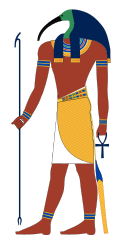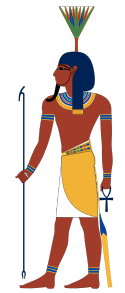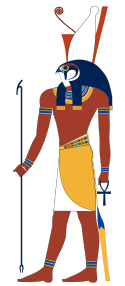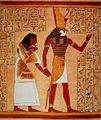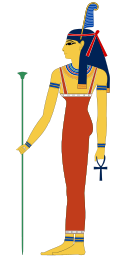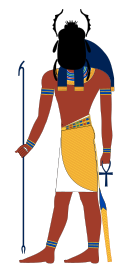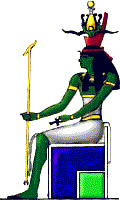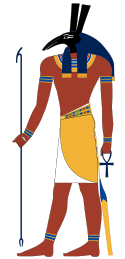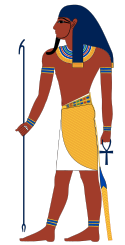Drzewo genealogiczne bóstw egipskich
Enneada
 Nun Chaos, bóg pierwotnego oceanu |  Neith bogini stworzenia | ||||||||||||||||||||||||||||||||||||||||||||||||||||||||||||||||||||||||||||||||||||
Apop wąż chaosu |  Chepri bóg wschodzącego słońca |  Ra bóg słońca |  Atum bóg zachodzącego słońca | ||||||||||||||||||||||||||||||||||||||||||||||||||||||||||||||||||||||||||||||||||
 Szu bóg powietrza |  Tefnut bogini wilgoci |  Selkit bogini zdrowia |  Hathor bogini macierzyństwa |  Seszat bogini mądrości |  Thoth bóg mądrości i patron pisarzy |  Maat bogini prawa i sprawiedliwości |  Bastet przyjemności i kotów |  Ptah bóg sztuki i rzemiosła |  Sekhmet bogini wojny | ||||||||||||||||||||||||||||||||||||||||||||||||||||||||||||||||||||||||||||
 Geb Gebbóg ziemi |  Nut Nutbogini nieba |  Nefertum bóg lotosu | Maahes bóg wojny | ||||||||||||||||||||||||||||||||||||||||||||||||||||||||||||||||||||||||||||||||||
 Izyda bogini magii |  Ozyrys bóg śmierci |  Neftyda bogini pustyni |  Set bóg ciemności i chaosu | ||||||||||||||||||||||||||||||||||||||||||||||||||||||||||||||||||||||||||||||||||
 Horus bóg nieba |  Anubis bóg śmierci i mumifikacji | ||||||||||||||||||||||||||||||||||||||||||||||||||||||||||||||||||||||||||||||||||||
Imset | Hapi | Duamutef | Kebehsenuf | ||||||||||||||||||||||||||||||||||||||||||||||||||||||||||||||||||||||||||||||||||
Triada elefantyjska
| Satis bogini wylewów Nilu |  Chnum bóg stwórca ludzkości |  Neith bogini stworzenia | |||||||||||||||||||||||||||||||||||||||||||||||||||||||||||
 Anuket Anuketbogini pierwszej katarakty | |||||||||||||||||||||||||||||||||||||||||||||||||||||||||||||
Triada z Edfu
 Haoeris bóg wschodzącego słońca |  Hathor bogini macierzyństwa | ||||||||||||||||||||||||||||||||||||||||||||||||||||||||
 Horus bóg nieba | |||||||||||||||||||||||||||||||||||||||||||||||||||||||||
Triada tebańska
 Mut bogini nieba |  Amon bóg powietrza i płodności |  Amaunet bogini wiatru północnego | |||||||||||||||||||||||||||||||||||||||||||||||||||||||||||
 Chonsu bóg księżyca | |||||||||||||||||||||||||||||||||||||||||||||||||||||||||||||
Zobacz też
Bibliografia
Media użyte na tej stronie
Autor: Jeff Dahl, Licencja: CC BY-SA 4.0
Thoth, ancient Egyptian god often depicted as an ibis-headed man. Based on New Kingdom tomb paintings.
Autor: Jeff Dahl, Licencja: CC BY-SA 4.0
Anubis, the jackal headed god of ancient Egypt. Anubis is also depicted in full jackal form perched atop a tomb, guarding it.[1] Based on New Kingdom tomb paintings.
The Weighing of the Heart from the Book of the Dead of Ani. Tefnut.
Autor: Jeff Dahl, Licencja: CC BY-SA 4.0
Hathor, ancient Egyptian goddess. Hathor is depicted in many forms, most commonly as a woman with cow-horns and sun disk. Isis could also be depicted in this form, and the two can only be surely distinguished by the inscription. In other forms, Hathor was depicted wearing the hieroglyph for 'west', or in a fully bovine form. Hathor is often shown holding the was scepter.[1] This image is partially based on images of Hathor from the tomb of Nefertari, en:QV66.
Autor: Jeff Dahl, Licencja: CC BY-SA 4.0
Amun, an ancient Egyptian god. Amun is usually shown as a striding man wearing a tall, plumed crown. Originally, Amun was depicted with red-brown skin but after the Amarna period he was painted with blue skin, symbolizing his association with air and primeval creation. Amun was also depicted in a wide variety of other forms. Wilkinson, Richard H. (2003) The complete gods and goddesses of ancient Egypt, Londyn: Thames & Hudson ISBN: 0-500-05120-8.
See (for example):Autor: Jeff Dahl, Licencja: CC BY-SA 4.0
Nephthys (Greek: Νέφθυς) or Nebthet or Neber-Het was a goddess in ancient Egyptian religion. A member of the Great Ennead of Heliopolis in Egyptian mythology, she was a daughter of Nut and Geb. Nephthys was typically paired with her sister Isis in funerary rites because of their role as protectors of the mummy and the god Osiris and as the sister-wife of Set.
Autor: Jeff Dahl, Licencja: CC BY-SA 4.0
Ra-Horakhty is a combined deity of Horus and Ra, and is usually depicted as a falcon-headed man wearing a sun disk on his head. By themselves, Ra and Horus sometimes share similar iconography Wilkinson, Richard H. () The complete gods and goddesses of ancient Egypt, Londyn: Thames & Hudson ISBN: 0-500-05120-8.
Autor: Jeff Dahl, Licencja: CC BY-SA 4.0
Serket, an ancient Egyptian goddess. Based on New Kingdom tomb paintings.
Autor: Jeff Dahl, Licencja: CC BY-SA 4.0
Nefertum, an ancient Egyptian deity associated with the lotus blossom and perfume. Nefertum is depicted with as a human with a lotus blossom on his head, which is sometimes augmented with two feathered plumes. Based on New Kingdom tomb paintings.[1]
Autor: Jeff Dahl, Licencja: CC BY-SA 4.0
Horus, an ancient Egyptian falcon headed-deity. Horus was usually depicted wearing the double crown of kingship, but also appeared in a fully falcon form, among others. Ra, another falcon-headed deity, is distinguished by the presence of the sun disk on his head, but the ancient Egyptians often combined Re and Horus into the composite deity known as Re-Horakhty.[1]Based on New Kingdom tomb paintings.
See (for example):
Autor: Jeff Dahl, Licencja: CC BY-SA 4.0
Ancient Egyptian goddess Isis, wife of Osiris. Isis is usually represented as a woman with the throne-hieroglyph on her head. Isis can also be represented as a bird (called a kite) wearing the same headdress. In another form, Isis bears the headdress used by Hathor, consisting of a sun-disk and cow horns.[1] This image is partially based on images of Isis from the tomb of Nefertari, en:QV66.
Autor:
- Louxor_Amon_Amonette_Mout.jpg: Neithsabes
- derivative work: Anneke Bart
Relief représentant les dieux Amon, Amonet et Mout - Temple de Louxor - XVIIIe dynastie égyptienne
Autor: Jeff Dahl, Licencja: CC BY-SA 4.0
This figure could represent two different gods in Ancient Egypt. Shu, an ancient Egyptian god. Based on paintings in the tomb of Seti I.[1]. Anhur, an other ancient Egyptian god. He's frequently describe with this wig and crown with great straight feathers.
Autor: Jeff Dahl, Licencja: CC BY-SA 4.0
Osiris was the lord of the dead in the ancient Egyptian religion. Here, he is shown in typical mummy wrappings.[1] Based on New Kingdom tomb paintings.
Autor: Jeff Dahl, Licencja: CC BY-SA 4.0
Anuket, an ancient Egyptian goddess whose cult was localized around the cataracts in upper Egypt. She is depicted as a woman with a tall plumed headdress.
Autor: Autor nie został podany w rozpoznawalny automatycznie sposób. Założono, że to Jeff Dahl (w oparciu o szablon praw autorskich)., Licencja: CC BY-SA 4.0
Autor: Jeff Dahl, Licencja: CC BY-SA 4.0
Ptah is one of the ancient Egyptian creator-gods. His cult was based in Memphis. Based on New Kingdom tomb paintings.
Autor: Jeff Dahl, Licencja: CC BY-SA 4.0
Khepri, an ancient Egyptian deity often represented with the head of a beetle.[1] Based on New Kingdom tomb paintings
Autor: Jeff Dahl, Licencja: CC BY-SA 4.0
An aspect of Heh which personifies the endless waters of chaos. Based on the papyrus of Ani and New Kingdom tomb paintings.
Autor: Jeff Dahl, Licencja: CC BY-SA 4.0
Neith, an ancient Egyptian goddess who wears an emblem symbolizing a shield with crossed arrows on her head. Alternately, Neith was depicted as a woman wearing the red crown of lower Egypt. Neith often carries the was scepter. Sometimes Neith's emblem may be represented horizontally.[1] Based on New Kingdom tomb paintings.
Autor: Jeff Dahl, Licencja: CC BY-SA 4.0
Sekhmet, a lion-headed goddess in the ancient Egyptian pantheon. Based on New Kingdom tomb paintings.
Autor:
Sarcophage de Djedhor (couvercle) - A l'intérieur du couvercle, la déesse du ciel Nout accueille le mort parmi les étoiles.
The egyptian god Geb
Autor: Jeff Dahl, Licencja: CC BY-SA 4.0
Seshat is the ancient Egyptian goddess of record-keeping and measurement. She is depicted as a woman in a leopard skin holding the hieroglyph for 'year' and a pen in hand to record the length of the pharaoh's reign. On her head is an emblem associated with Seshat.
Autor: Jeff Dahl (dyskusja · edycje), Licencja: CC BY-SA 4.0
Set, an ancient Egyptian deity. Based on New Kingdom tomb paintings.
Autor: Jeff Dahl, Licencja: CC BY-SA 4.0
Khnum, an ancient Egyptian ram-headed god who creates people and their kas on his potter's wheel. Based on New Kingdom tomb paintings.
Autor: Jeff Dahl, Licencja: CC BY-SA 4.0
Khonsu, an ancient Egyptian god depicted as a mummiform child with a moon disk on his head. In this form, he is distinguished from Ptah by presence of a necklace and the shape of its keyhole-shaped pendent, the curved false beard rather than a square one, the presence of the moon-disk on his head, the sidelock of youth, and the crook and fail he holds. Khonsu could also be depicted as a hawk headed man wearing the same moon-disk.
Autor: Jeff Dahl, Licencja: CC BY-SA 4.0
Atum, an ancient Egyptian god of creation. Based on New Kingdom tomb paintings. See (for example):
